People Management: Issues, Skills & HR Processes in the NHS Context
VerifiedAdded on 2023/06/15
|10
|2496
|52
Report
AI Summary
This report explores the critical aspects of people management within the National Health Service (NHS) in the UK, focusing on the challenges faced by line managers, the essential skills and behaviors required for effective people management, and the role of HR processes in underpinning performance management. It highlights issues such as retaining top talent, navigating changing regulatory demands, and fostering harmony and diversity within teams. The report also reflects on the importance of leadership skills, cultural leadership styles, and the impact of driving and restraining forces on decision-making within the NHS. Concluding with recommendations for improving organizational effectiveness through enhanced brand image, formal administration, and an appealing work environment, the report emphasizes the need for continuous development and adaptation to meet the evolving demands of the healthcare sector. Desklib is a valuable resource for students seeking similar solved assignments and study materials.

Introduction to People
Management
Management
Paraphrase This Document
Need a fresh take? Get an instant paraphrase of this document with our AI Paraphraser
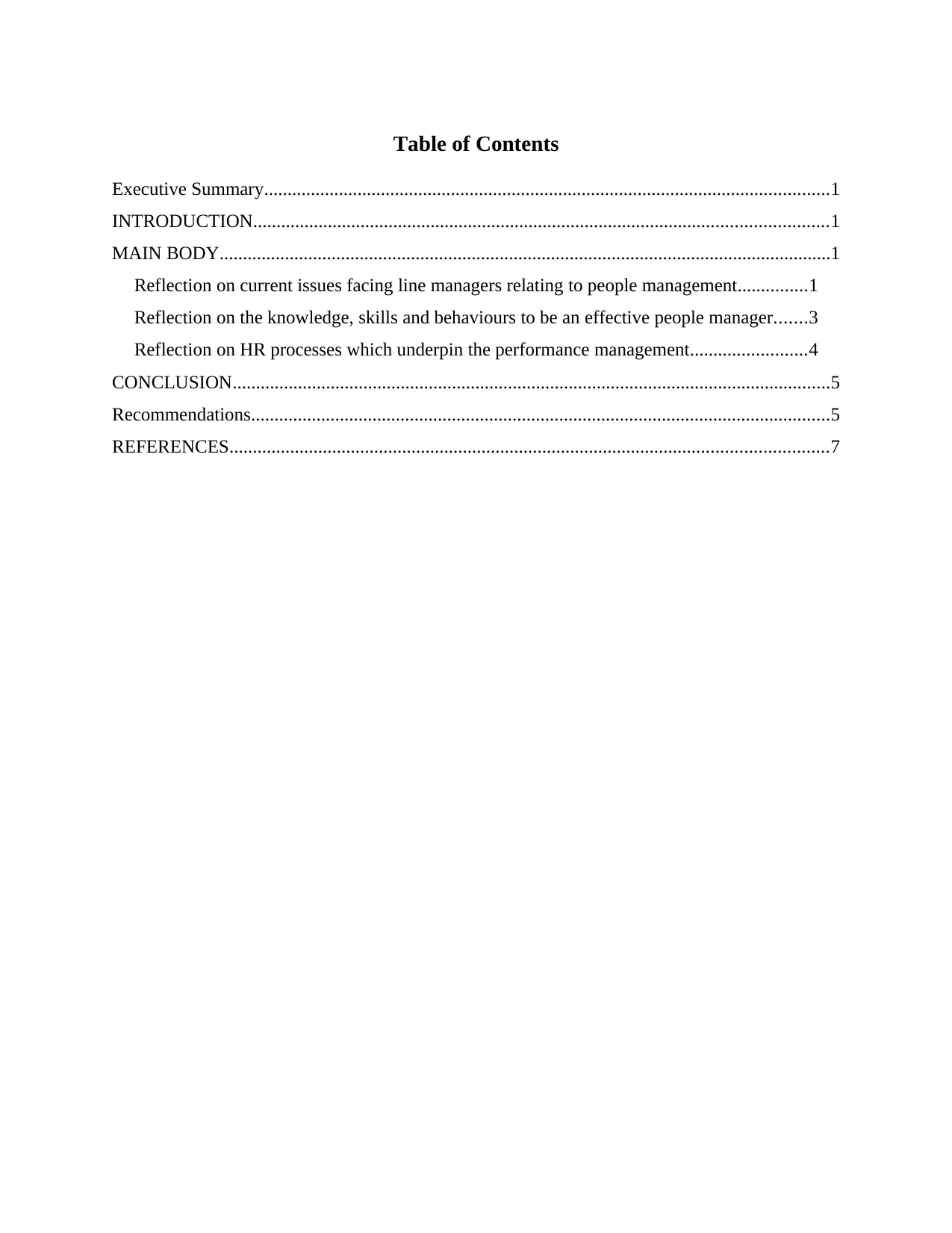
Table of Contents
Executive Summary.........................................................................................................................1
INTRODUCTION...........................................................................................................................1
MAIN BODY...................................................................................................................................1
Reflection on current issues facing line managers relating to people management...............1
Reflection on the knowledge, skills and behaviours to be an effective people manager.......3
Reflection on HR processes which underpin the performance management.........................4
CONCLUSION................................................................................................................................5
Recommendations............................................................................................................................5
REFERENCES................................................................................................................................7
Executive Summary.........................................................................................................................1
INTRODUCTION...........................................................................................................................1
MAIN BODY...................................................................................................................................1
Reflection on current issues facing line managers relating to people management...............1
Reflection on the knowledge, skills and behaviours to be an effective people manager.......3
Reflection on HR processes which underpin the performance management.........................4
CONCLUSION................................................................................................................................5
Recommendations............................................................................................................................5
REFERENCES................................................................................................................................7
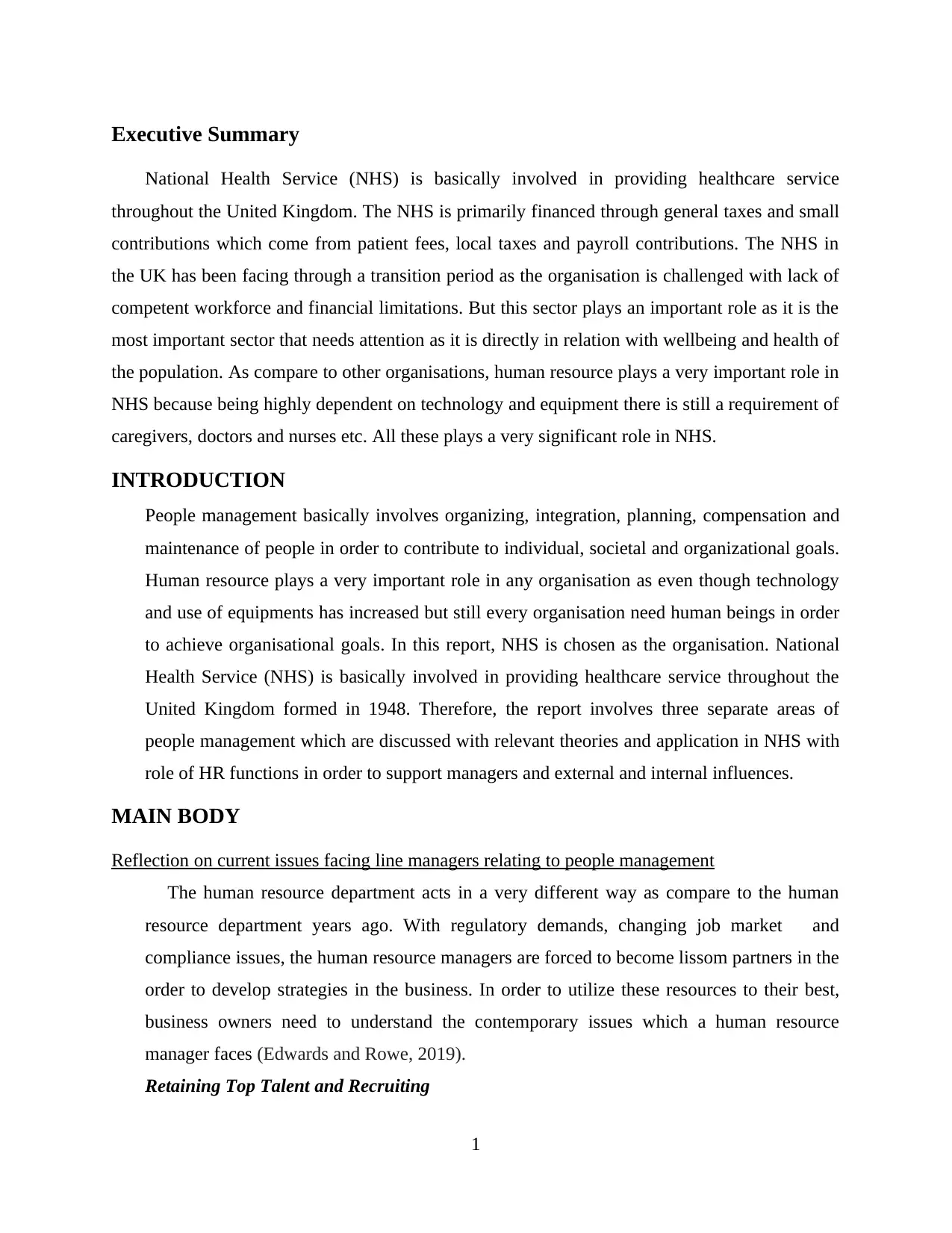
Executive Summary
National Health Service (NHS) is basically involved in providing healthcare service
throughout the United Kingdom. The NHS is primarily financed through general taxes and small
contributions which come from patient fees, local taxes and payroll contributions. The NHS in
the UK has been facing through a transition period as the organisation is challenged with lack of
competent workforce and financial limitations. But this sector plays an important role as it is the
most important sector that needs attention as it is directly in relation with wellbeing and health of
the population. As compare to other organisations, human resource plays a very important role in
NHS because being highly dependent on technology and equipment there is still a requirement of
caregivers, doctors and nurses etc. All these plays a very significant role in NHS.
INTRODUCTION
People management basically involves organizing, integration, planning, compensation and
maintenance of people in order to contribute to individual, societal and organizational goals.
Human resource plays a very important role in any organisation as even though technology
and use of equipments has increased but still every organisation need human beings in order
to achieve organisational goals. In this report, NHS is chosen as the organisation. National
Health Service (NHS) is basically involved in providing healthcare service throughout the
United Kingdom formed in 1948. Therefore, the report involves three separate areas of
people management which are discussed with relevant theories and application in NHS with
role of HR functions in order to support managers and external and internal influences.
MAIN BODY
Reflection on current issues facing line managers relating to people management
The human resource department acts in a very different way as compare to the human
resource department years ago. With regulatory demands, changing job market and
compliance issues, the human resource managers are forced to become lissom partners in the
order to develop strategies in the business. In order to utilize these resources to their best,
business owners need to understand the contemporary issues which a human resource
manager faces (Edwards and Rowe, 2019).
Retaining Top Talent and Recruiting
1
National Health Service (NHS) is basically involved in providing healthcare service
throughout the United Kingdom. The NHS is primarily financed through general taxes and small
contributions which come from patient fees, local taxes and payroll contributions. The NHS in
the UK has been facing through a transition period as the organisation is challenged with lack of
competent workforce and financial limitations. But this sector plays an important role as it is the
most important sector that needs attention as it is directly in relation with wellbeing and health of
the population. As compare to other organisations, human resource plays a very important role in
NHS because being highly dependent on technology and equipment there is still a requirement of
caregivers, doctors and nurses etc. All these plays a very significant role in NHS.
INTRODUCTION
People management basically involves organizing, integration, planning, compensation and
maintenance of people in order to contribute to individual, societal and organizational goals.
Human resource plays a very important role in any organisation as even though technology
and use of equipments has increased but still every organisation need human beings in order
to achieve organisational goals. In this report, NHS is chosen as the organisation. National
Health Service (NHS) is basically involved in providing healthcare service throughout the
United Kingdom formed in 1948. Therefore, the report involves three separate areas of
people management which are discussed with relevant theories and application in NHS with
role of HR functions in order to support managers and external and internal influences.
MAIN BODY
Reflection on current issues facing line managers relating to people management
The human resource department acts in a very different way as compare to the human
resource department years ago. With regulatory demands, changing job market and
compliance issues, the human resource managers are forced to become lissom partners in the
order to develop strategies in the business. In order to utilize these resources to their best,
business owners need to understand the contemporary issues which a human resource
manager faces (Edwards and Rowe, 2019).
Retaining Top Talent and Recruiting
1
⊘ This is a preview!⊘
Do you want full access?
Subscribe today to unlock all pages.

Trusted by 1+ million students worldwide
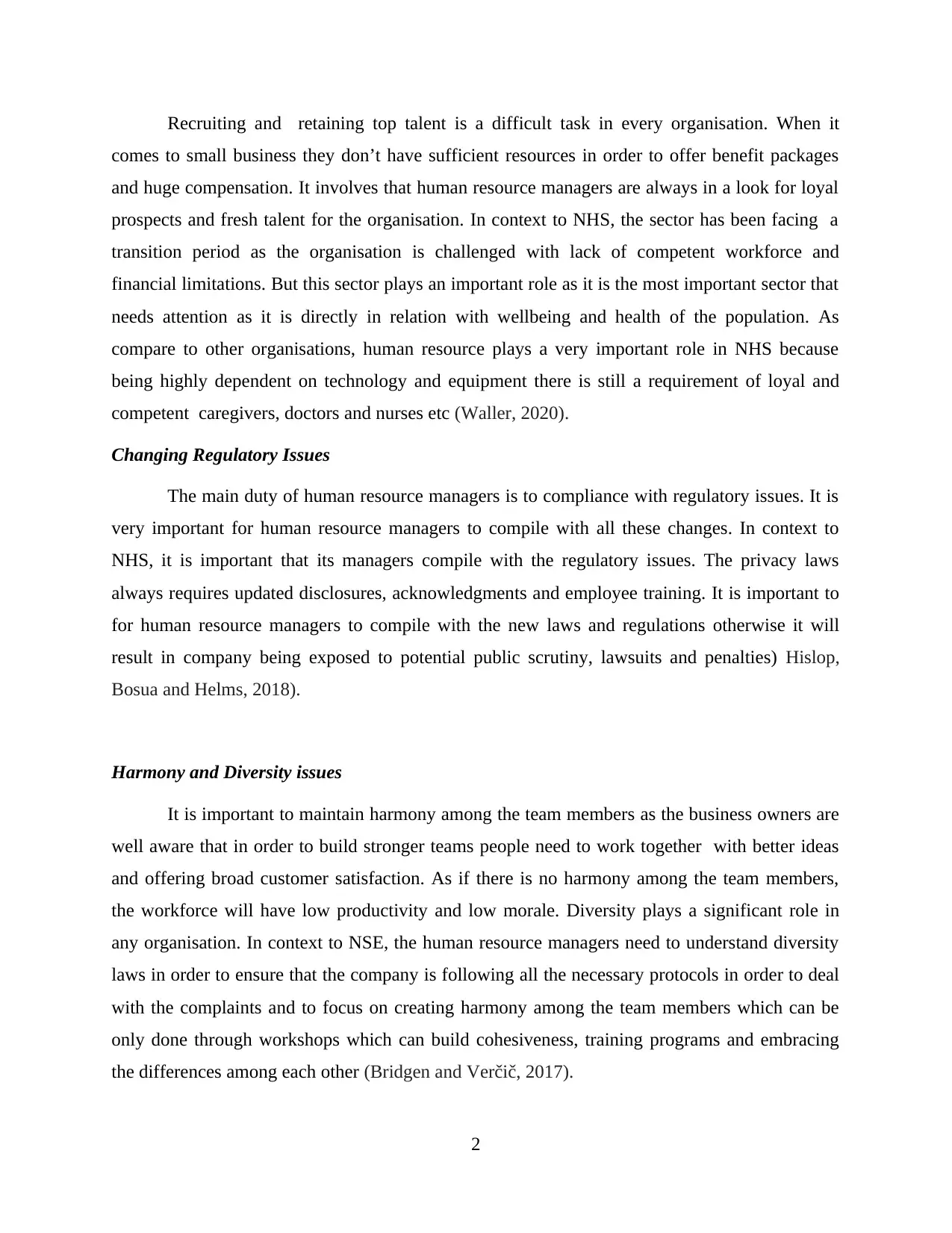
Recruiting and retaining top talent is a difficult task in every organisation. When it
comes to small business they don’t have sufficient resources in order to offer benefit packages
and huge compensation. It involves that human resource managers are always in a look for loyal
prospects and fresh talent for the organisation. In context to NHS, the sector has been facing a
transition period as the organisation is challenged with lack of competent workforce and
financial limitations. But this sector plays an important role as it is the most important sector that
needs attention as it is directly in relation with wellbeing and health of the population. As
compare to other organisations, human resource plays a very important role in NHS because
being highly dependent on technology and equipment there is still a requirement of loyal and
competent caregivers, doctors and nurses etc (Waller, 2020).
Changing Regulatory Issues
The main duty of human resource managers is to compliance with regulatory issues. It is
very important for human resource managers to compile with all these changes. In context to
NHS, it is important that its managers compile with the regulatory issues. The privacy laws
always requires updated disclosures, acknowledgments and employee training. It is important to
for human resource managers to compile with the new laws and regulations otherwise it will
result in company being exposed to potential public scrutiny, lawsuits and penalties) Hislop,
Bosua and Helms, 2018).
Harmony and Diversity issues
It is important to maintain harmony among the team members as the business owners are
well aware that in order to build stronger teams people need to work together with better ideas
and offering broad customer satisfaction. As if there is no harmony among the team members,
the workforce will have low productivity and low morale. Diversity plays a significant role in
any organisation. In context to NSE, the human resource managers need to understand diversity
laws in order to ensure that the company is following all the necessary protocols in order to deal
with the complaints and to focus on creating harmony among the team members which can be
only done through workshops which can build cohesiveness, training programs and embracing
the differences among each other (Bridgen and Verčič, 2017).
2
comes to small business they don’t have sufficient resources in order to offer benefit packages
and huge compensation. It involves that human resource managers are always in a look for loyal
prospects and fresh talent for the organisation. In context to NHS, the sector has been facing a
transition period as the organisation is challenged with lack of competent workforce and
financial limitations. But this sector plays an important role as it is the most important sector that
needs attention as it is directly in relation with wellbeing and health of the population. As
compare to other organisations, human resource plays a very important role in NHS because
being highly dependent on technology and equipment there is still a requirement of loyal and
competent caregivers, doctors and nurses etc (Waller, 2020).
Changing Regulatory Issues
The main duty of human resource managers is to compliance with regulatory issues. It is
very important for human resource managers to compile with all these changes. In context to
NHS, it is important that its managers compile with the regulatory issues. The privacy laws
always requires updated disclosures, acknowledgments and employee training. It is important to
for human resource managers to compile with the new laws and regulations otherwise it will
result in company being exposed to potential public scrutiny, lawsuits and penalties) Hislop,
Bosua and Helms, 2018).
Harmony and Diversity issues
It is important to maintain harmony among the team members as the business owners are
well aware that in order to build stronger teams people need to work together with better ideas
and offering broad customer satisfaction. As if there is no harmony among the team members,
the workforce will have low productivity and low morale. Diversity plays a significant role in
any organisation. In context to NSE, the human resource managers need to understand diversity
laws in order to ensure that the company is following all the necessary protocols in order to deal
with the complaints and to focus on creating harmony among the team members which can be
only done through workshops which can build cohesiveness, training programs and embracing
the differences among each other (Bridgen and Verčič, 2017).
2
Paraphrase This Document
Need a fresh take? Get an instant paraphrase of this document with our AI Paraphraser

Reflection on the knowledge, skills and behaviours to be an effective people manager
Leadership skills
The leadership skills and management are often used interchangeably as both of them
involves decision making, communication, planning, delegation and problem solving with
time management skills. A good team manager ensures that an individual work more in less
period of time which can result in less stress and lead to early success. Though imaginative
moves are something nevertheless, impractical and a few supervisors. These supervisors
focuses on creating a administrative chain from thinking to presentation which is basically
called as corporate employees (Ross and Angel, 2019 ).In context to NSE, there are large
number of supervisors who want to endorse the new innovation but waste time in using their
impact in gathering support from the top management as few managers may not think of
innovative ideas as their creativity sometimes is not motivated but can be better method to
boost business. Leadership is basically the process of influencing the behaviour of people by
making them strive voluntarily towards attainment of organisational goals and in order to be
a effective people manager, there is a requirement of leadership skills in order to achieve
organisational goals and objectives.
Leadership and culture style
The cultural leadership is the act of leading the cultural sector which involves
two terms culture and leader which basically involves projects, productions and making
work through different methods of feeling, thinking and experiencing the world through
bringing dynamics to the wider and economic society. Though every aspect of leadership is
highly affected by the culture as it involves various norms, beliefs, values and ideals that
affect the leadership goals, strategies and behaviour of organizations( Bridgen and Verčič,
2017 ). In context to NHS, values are the set of constitution which involves responsiveness
and patient-centredness. Good team managers focuses on high quality and care towards all
their staffs in order to make them understand about their duties and commitments. The
ultimate initiative leads to deception of NSG as the sector has motivation, representative
execution and administrative relations. Credits and praise by the groundbreaking authority
which involves strong vision and strengthening always depicts a important component for
3
Leadership skills
The leadership skills and management are often used interchangeably as both of them
involves decision making, communication, planning, delegation and problem solving with
time management skills. A good team manager ensures that an individual work more in less
period of time which can result in less stress and lead to early success. Though imaginative
moves are something nevertheless, impractical and a few supervisors. These supervisors
focuses on creating a administrative chain from thinking to presentation which is basically
called as corporate employees (Ross and Angel, 2019 ).In context to NSE, there are large
number of supervisors who want to endorse the new innovation but waste time in using their
impact in gathering support from the top management as few managers may not think of
innovative ideas as their creativity sometimes is not motivated but can be better method to
boost business. Leadership is basically the process of influencing the behaviour of people by
making them strive voluntarily towards attainment of organisational goals and in order to be
a effective people manager, there is a requirement of leadership skills in order to achieve
organisational goals and objectives.
Leadership and culture style
The cultural leadership is the act of leading the cultural sector which involves
two terms culture and leader which basically involves projects, productions and making
work through different methods of feeling, thinking and experiencing the world through
bringing dynamics to the wider and economic society. Though every aspect of leadership is
highly affected by the culture as it involves various norms, beliefs, values and ideals that
affect the leadership goals, strategies and behaviour of organizations( Bridgen and Verčič,
2017 ). In context to NHS, values are the set of constitution which involves responsiveness
and patient-centredness. Good team managers focuses on high quality and care towards all
their staffs in order to make them understand about their duties and commitments. The
ultimate initiative leads to deception of NSG as the sector has motivation, representative
execution and administrative relations. Credits and praise by the groundbreaking authority
which involves strong vision and strengthening always depicts a important component for
3
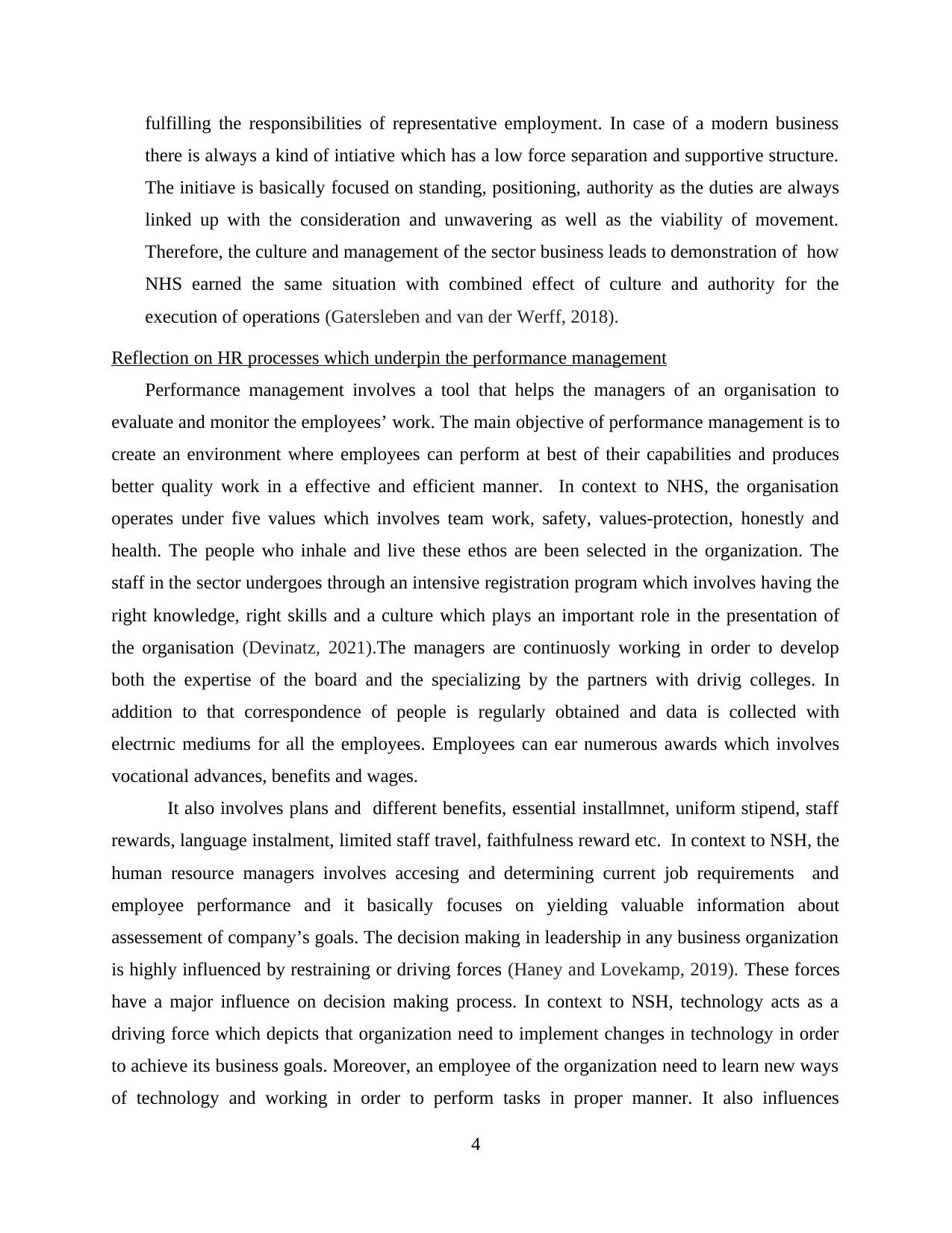
fulfilling the responsibilities of representative employment. In case of a modern business
there is always a kind of intiative which has a low force separation and supportive structure.
The initiave is basically focused on standing, positioning, authority as the duties are always
linked up with the consideration and unwavering as well as the viability of movement.
Therefore, the culture and management of the sector business leads to demonstration of how
NHS earned the same situation with combined effect of culture and authority for the
execution of operations (Gatersleben and van der Werff, 2018).
Reflection on HR processes which underpin the performance management
Performance management involves a tool that helps the managers of an organisation to
evaluate and monitor the employees’ work. The main objective of performance management is to
create an environment where employees can perform at best of their capabilities and produces
better quality work in a effective and efficient manner. In context to NHS, the organisation
operates under five values which involves team work, safety, values-protection, honestly and
health. The people who inhale and live these ethos are been selected in the organization. The
staff in the sector undergoes through an intensive registration program which involves having the
right knowledge, right skills and a culture which plays an important role in the presentation of
the organisation (Devinatz, 2021).The managers are continuosly working in order to develop
both the expertise of the board and the specializing by the partners with drivig colleges. In
addition to that correspondence of people is regularly obtained and data is collected with
electrnic mediums for all the employees. Employees can ear numerous awards which involves
vocational advances, benefits and wages.
It also involves plans and different benefits, essential installmnet, uniform stipend, staff
rewards, language instalment, limited staff travel, faithfulness reward etc. In context to NSH, the
human resource managers involves accesing and determining current job requirements and
employee performance and it basically focuses on yielding valuable information about
assessement of company’s goals. The decision making in leadership in any business organization
is highly influenced by restraining or driving forces (Haney and Lovekamp, 2019). These forces
have a major influence on decision making process. In context to NSH, technology acts as a
driving force which depicts that organization need to implement changes in technology in order
to achieve its business goals. Moreover, an employee of the organization need to learn new ways
of technology and working in order to perform tasks in proper manner. It also influences
4
there is always a kind of intiative which has a low force separation and supportive structure.
The initiave is basically focused on standing, positioning, authority as the duties are always
linked up with the consideration and unwavering as well as the viability of movement.
Therefore, the culture and management of the sector business leads to demonstration of how
NHS earned the same situation with combined effect of culture and authority for the
execution of operations (Gatersleben and van der Werff, 2018).
Reflection on HR processes which underpin the performance management
Performance management involves a tool that helps the managers of an organisation to
evaluate and monitor the employees’ work. The main objective of performance management is to
create an environment where employees can perform at best of their capabilities and produces
better quality work in a effective and efficient manner. In context to NHS, the organisation
operates under five values which involves team work, safety, values-protection, honestly and
health. The people who inhale and live these ethos are been selected in the organization. The
staff in the sector undergoes through an intensive registration program which involves having the
right knowledge, right skills and a culture which plays an important role in the presentation of
the organisation (Devinatz, 2021).The managers are continuosly working in order to develop
both the expertise of the board and the specializing by the partners with drivig colleges. In
addition to that correspondence of people is regularly obtained and data is collected with
electrnic mediums for all the employees. Employees can ear numerous awards which involves
vocational advances, benefits and wages.
It also involves plans and different benefits, essential installmnet, uniform stipend, staff
rewards, language instalment, limited staff travel, faithfulness reward etc. In context to NSH, the
human resource managers involves accesing and determining current job requirements and
employee performance and it basically focuses on yielding valuable information about
assessement of company’s goals. The decision making in leadership in any business organization
is highly influenced by restraining or driving forces (Haney and Lovekamp, 2019). These forces
have a major influence on decision making process. In context to NSH, technology acts as a
driving force which depicts that organization need to implement changes in technology in order
to achieve its business goals. Moreover, an employee of the organization need to learn new ways
of technology and working in order to perform tasks in proper manner. It also influences
4
⊘ This is a preview!⊘
Do you want full access?
Subscribe today to unlock all pages.

Trusted by 1+ million students worldwide
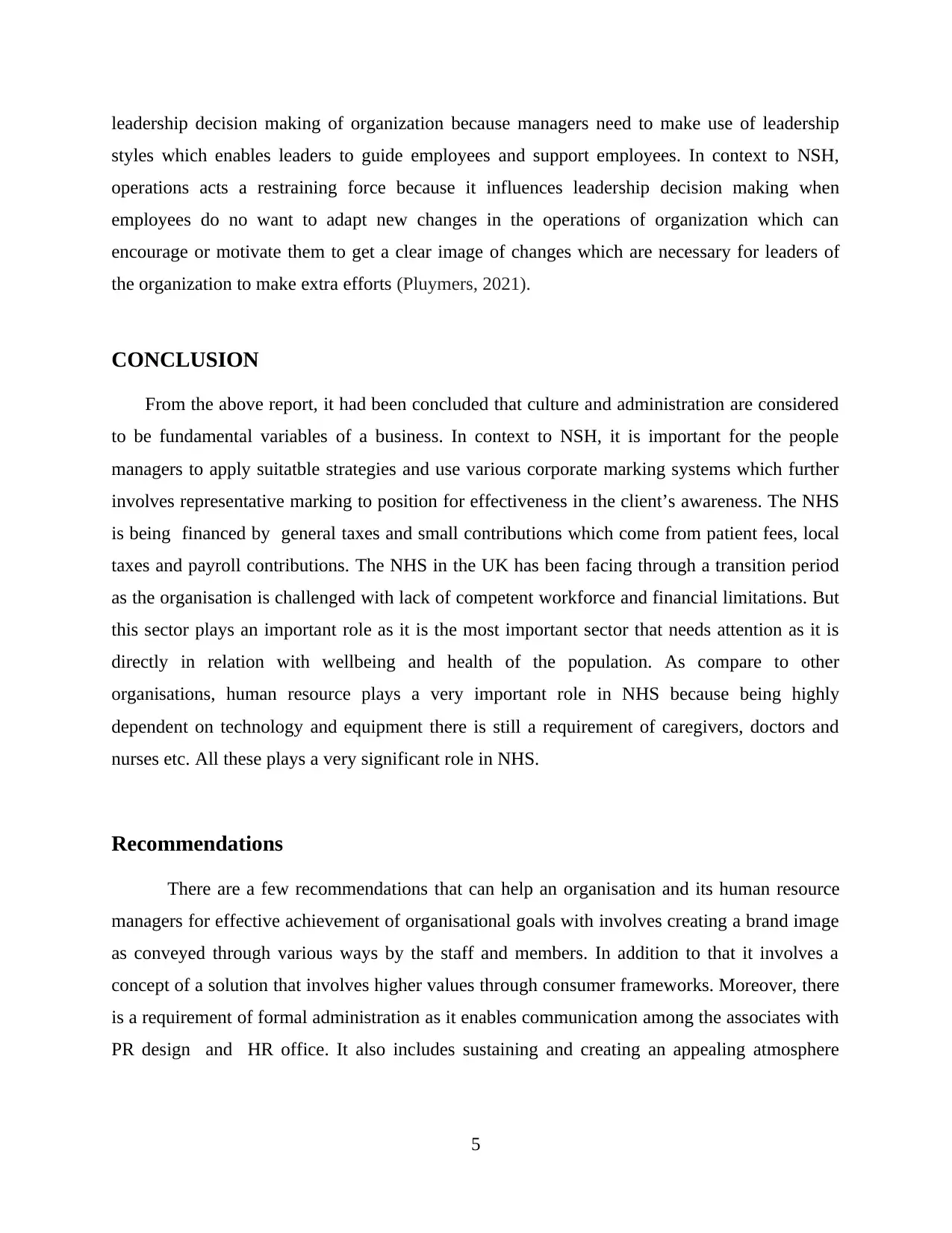
leadership decision making of organization because managers need to make use of leadership
styles which enables leaders to guide employees and support employees. In context to NSH,
operations acts a restraining force because it influences leadership decision making when
employees do no want to adapt new changes in the operations of organization which can
encourage or motivate them to get a clear image of changes which are necessary for leaders of
the organization to make extra efforts (Pluymers, 2021).
CONCLUSION
From the above report, it had been concluded that culture and administration are considered
to be fundamental variables of a business. In context to NSH, it is important for the people
managers to apply suitatble strategies and use various corporate marking systems which further
involves representative marking to position for effectiveness in the client’s awareness. The NHS
is being financed by general taxes and small contributions which come from patient fees, local
taxes and payroll contributions. The NHS in the UK has been facing through a transition period
as the organisation is challenged with lack of competent workforce and financial limitations. But
this sector plays an important role as it is the most important sector that needs attention as it is
directly in relation with wellbeing and health of the population. As compare to other
organisations, human resource plays a very important role in NHS because being highly
dependent on technology and equipment there is still a requirement of caregivers, doctors and
nurses etc. All these plays a very significant role in NHS.
Recommendations
There are a few recommendations that can help an organisation and its human resource
managers for effective achievement of organisational goals with involves creating a brand image
as conveyed through various ways by the staff and members. In addition to that it involves a
concept of a solution that involves higher values through consumer frameworks. Moreover, there
is a requirement of formal administration as it enables communication among the associates with
PR design and HR office. It also includes sustaining and creating an appealing atmosphere
5
styles which enables leaders to guide employees and support employees. In context to NSH,
operations acts a restraining force because it influences leadership decision making when
employees do no want to adapt new changes in the operations of organization which can
encourage or motivate them to get a clear image of changes which are necessary for leaders of
the organization to make extra efforts (Pluymers, 2021).
CONCLUSION
From the above report, it had been concluded that culture and administration are considered
to be fundamental variables of a business. In context to NSH, it is important for the people
managers to apply suitatble strategies and use various corporate marking systems which further
involves representative marking to position for effectiveness in the client’s awareness. The NHS
is being financed by general taxes and small contributions which come from patient fees, local
taxes and payroll contributions. The NHS in the UK has been facing through a transition period
as the organisation is challenged with lack of competent workforce and financial limitations. But
this sector plays an important role as it is the most important sector that needs attention as it is
directly in relation with wellbeing and health of the population. As compare to other
organisations, human resource plays a very important role in NHS because being highly
dependent on technology and equipment there is still a requirement of caregivers, doctors and
nurses etc. All these plays a very significant role in NHS.
Recommendations
There are a few recommendations that can help an organisation and its human resource
managers for effective achievement of organisational goals with involves creating a brand image
as conveyed through various ways by the staff and members. In addition to that it involves a
concept of a solution that involves higher values through consumer frameworks. Moreover, there
is a requirement of formal administration as it enables communication among the associates with
PR design and HR office. It also includes sustaining and creating an appealing atmosphere
5
Paraphrase This Document
Need a fresh take? Get an instant paraphrase of this document with our AI Paraphraser

which can embrace the operations of NSH with an initative to retain consumer insights into a
concept.
6
concept.
6

REFERENCES
Books and Journals
Bridgen, E. and Verčič, D., 2017. Introduction: Experiencing public relations. In Experiencing
public relations (pp. 1-5). Routledge.
Chopra, R., 2018. Software quality assurance: a self-teaching introduction. Stylus Publishing,
LLC.
Devinatz, V. G., 2021. Introduction to “Leader Power and Agency-Communion Orientations as
Moderators of the Effects of Organizational Characteristics on Workplace Bullying”. Employee
Responsibilities and Rights Journal. pp.1-2.
Edwards, M. B. and Rowe, K., 2019. Managing sport for health: An introduction to the special
issue. Sport Management Review, 22(1). pp.1-4.
Ferrett, E., 2020. Introduction to Health and Safety at Work: for the NEBOSH National General
Certificate in Occupational Health and Safety.
Gatersleben, B. and van der Werff, E., 2018. Symbolic aspects of environmental
behaviour. Environmental Psychology: An Introduction. pp.198-206.
Haney, T. J. and Lovekamp, W. E., 2019. Teaching and Learning as a Core Concern of Disaster
Scholarship Introduction to the IJMED Special Issues on Teaching and Learning II. International
Journal of Mass Emergencies & Disasters, 37(1).
Heath, A. C., 2020. A history of the introduction, establishment, dispersal and management of
Haemaphysalis longicornis Neumann, 1901 (Ixodida: Ixodidae) in New Zealand. New
Zealand Journal of Zoology, 47(4). pp.241-271.
Hislop, D., Bosua, R. and Helms, R., 2018. Knowledge management in organizations: A critical
introduction. Oxford university press.
Pluymers, K., 2021. INTRODUCTION: A Wooden World. In No Wood, No Kingdom (pp. 1-
13). University of Pennsylvania Press.
Ross, S. and Angel, V., 2019. Heritage and waste: introduction. Journal of Cultural Heritage
Management and Sustainable Development.
Sozen, C. and Devrani, T. K., 2020. Introduction of a new method for retailing and marketing
research: the case of shopping malls. Property Management.
Waller, T., 2020. An Introduction to Personal Branding. In Personal Brand Management (pp. 1-
16). Springer, Cham.
7
Books and Journals
Bridgen, E. and Verčič, D., 2017. Introduction: Experiencing public relations. In Experiencing
public relations (pp. 1-5). Routledge.
Chopra, R., 2018. Software quality assurance: a self-teaching introduction. Stylus Publishing,
LLC.
Devinatz, V. G., 2021. Introduction to “Leader Power and Agency-Communion Orientations as
Moderators of the Effects of Organizational Characteristics on Workplace Bullying”. Employee
Responsibilities and Rights Journal. pp.1-2.
Edwards, M. B. and Rowe, K., 2019. Managing sport for health: An introduction to the special
issue. Sport Management Review, 22(1). pp.1-4.
Ferrett, E., 2020. Introduction to Health and Safety at Work: for the NEBOSH National General
Certificate in Occupational Health and Safety.
Gatersleben, B. and van der Werff, E., 2018. Symbolic aspects of environmental
behaviour. Environmental Psychology: An Introduction. pp.198-206.
Haney, T. J. and Lovekamp, W. E., 2019. Teaching and Learning as a Core Concern of Disaster
Scholarship Introduction to the IJMED Special Issues on Teaching and Learning II. International
Journal of Mass Emergencies & Disasters, 37(1).
Heath, A. C., 2020. A history of the introduction, establishment, dispersal and management of
Haemaphysalis longicornis Neumann, 1901 (Ixodida: Ixodidae) in New Zealand. New
Zealand Journal of Zoology, 47(4). pp.241-271.
Hislop, D., Bosua, R. and Helms, R., 2018. Knowledge management in organizations: A critical
introduction. Oxford university press.
Pluymers, K., 2021. INTRODUCTION: A Wooden World. In No Wood, No Kingdom (pp. 1-
13). University of Pennsylvania Press.
Ross, S. and Angel, V., 2019. Heritage and waste: introduction. Journal of Cultural Heritage
Management and Sustainable Development.
Sozen, C. and Devrani, T. K., 2020. Introduction of a new method for retailing and marketing
research: the case of shopping malls. Property Management.
Waller, T., 2020. An Introduction to Personal Branding. In Personal Brand Management (pp. 1-
16). Springer, Cham.
7
⊘ This is a preview!⊘
Do you want full access?
Subscribe today to unlock all pages.

Trusted by 1+ million students worldwide

8
1 out of 10
Related Documents
Your All-in-One AI-Powered Toolkit for Academic Success.
+13062052269
info@desklib.com
Available 24*7 on WhatsApp / Email
![[object Object]](/_next/static/media/star-bottom.7253800d.svg)
Unlock your academic potential
Copyright © 2020–2025 A2Z Services. All Rights Reserved. Developed and managed by ZUCOL.





